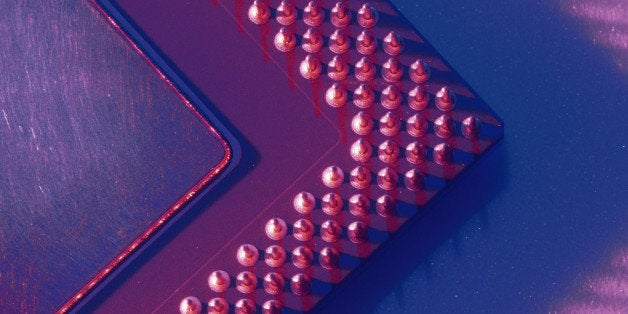
When you search for something on Google, the query travels the Internet at a rate of hundreds of millions of miles per hour -- a speed close to the speed of light. But the computer you searched on can't work that fast, so the information actually has to slow down when it reaches your machine.
But one day, that could change. New research out of England has provided a blueprint for creating computers that can transfer information within a computer at the speed of light. Of course, transferring the information is just one part of the puzzle, as project lead Dr. Richard Curry, a Ph.D. who works at the University of Surrey's Advanced Technology Institute, told The Huffington Post. Curry studies different applications for materials in electronic and optical technology.
"The aim would be to send data around the computer using light," Curry said through a spokesperson via email. "The challenge would then be to be able to process that data at a similar rate."
A visualization of electrical transistors within a microprocessor. While it may look cool, this "slow" process of transferring electrical signals is what researchers hope to replace. (Source: Global Foundries)
The research by Curry's team -- from the University of Surrey, University of Cambridge and University of Southampton -- ideally solves both problems. They propose that an "amorphous" glass material could be used to create an optical system in computers that both transfers and processes information using light -- just like the optical system used to move information through the Internet. The research was published last week in the journal Nature Communications.
Currently, the heart of your machine is a microprocessor, a chip that sends information via tiny electrical wires. Australian site ScienceAlert reports that we're reaching a moment in time when these wires physically can't get any smaller. And when that happens, computers will stop getting faster, meaning new technology needs to be developed to speed them up. The new method, in other words, would be a replacement for electric microprocessors.
"[Using light to transfer and process data in a computer] has eluded researchers for decades," Curry said in a press release, and he's not exaggerating: Optical computing has been a topic of academic discussion since at least 1988, when the award-winning "Optical Computing: A Survey for Computer Scientists" was published by MIT Press.
"This could transform the computers of tomorrow, allowing them to effectively process information at much faster speeds," Curry added.
Researchers say the new light-based system could be used in computers within 10 years, though it's not clear when it'll be available to consumers.
